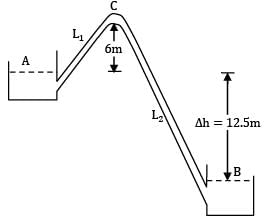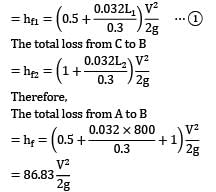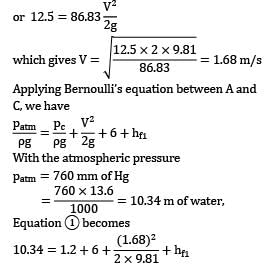Civil Engineering (CE) Exam > Civil Engineering (CE) Questions > Two reservoirs open to the atmosphere are co...
Start Learning for Free
Two reservoirs open to the atmosphere are connected by a pipe 800 metres long. The pipe goes over a hill whose height is 6 m above the level of water in the upper reservoir. The pipe diameter is 300 mm and friction factor f = 0.032. The difference in water levels in the two reservoirs is 12.5 m. If the absolute pressure of water anywhere in the pipe is not allowed to fall below 1.2 m of water in order to prevent vapour formation, calculate the length of pipe in the portion between the upper reservoir and the hill summit. Neglect bend losses.
Correct answer is 'Range: 180 to 200'. Can you explain this answer?
Most Upvoted Answer
Two reservoirs open to the atmosphere are connected by a pipe 800 met...

Let the length of pipe upstream of C be L1 and that of the downstream be L2 It is given L1 + L2 = 800 m Considering the entry, friction and exit losses, The total loss from A to C

Applying Bernoulli’s equation between ! and B, we have
Δ H = hf

which gives hf1 = 2.99 m Using the value of hf1 = 2.99 m, and V = 1.68 m/s in equation ① we get

Free Test
| FREE | Start Free Test |
Community Answer
Two reservoirs open to the atmosphere are connected by a pipe 800 met...
Given information:
- Two reservoirs are connected by a pipe 800 meters long.
- The pipe goes over a hill with a height of 6 meters above the level of water in the upper reservoir.
- Pipe diameter = 300 mm
- Friction factor (f) = 0.032
- Difference in water levels = 12.5 meters
- Minimum pressure to prevent vapor formation = 1.2 meters of water
To find:
- Length of the pipe between the upper reservoir and the hill summit.
Assumptions:
- Steady flow conditions
- Incompressible and frictional flow
- Neglecting bend losses
Calculations:
1. Head Loss due to elevation:
The head loss due to elevation can be calculated using the equation:
where,
h_elevation = head loss due to elevation
h_hill = height of the hill = 6 meters
h_pipe = head loss due to pipe length
2. Head Loss due to friction:
The head loss due to friction can be calculated using the Darcy-Weisbach equation:
where,
h_friction = head loss due to friction
f = friction factor = 0.032
L = length of the pipe = 800 meters
D = diameter of the pipe = 300 mm = 0.3 meters
V = velocity of the flow
g = acceleration due to gravity = 9.81 m/s²
3. Total head loss:
The total head loss is the sum of the head loss due to elevation and the head loss due to friction:
4. Length of pipe between upper reservoir and hill summit:
The length of pipe between the upper reservoir and the hill summit can be calculated by rearranging the above equation:
5. Solving for velocity:
The velocity can be found using the equation:
where,
Q = volumetric flow rate
A = cross-sectional area of the pipe
6. Solving for cross-sectional area:
The cross-sectional area can be calculated using the equation:
7. Solving for volumetric flow rate:
The volumetric flow rate can be calculated using the equation:
8. Substituting values and calculating:
- Convert the diameter from mm to meters: D = 0.3 m
- Calculate the cross-sectional area: A = π * (0.3/2)^2 = 0.0707 m²
- Rearrange the equation for volumetric flow rate: Q = A * V
- Rearrange the equation for velocity: V = Q / A
- Substitute the values of D and A to
- Two reservoirs are connected by a pipe 800 meters long.
- The pipe goes over a hill with a height of 6 meters above the level of water in the upper reservoir.
- Pipe diameter = 300 mm
- Friction factor (f) = 0.032
- Difference in water levels = 12.5 meters
- Minimum pressure to prevent vapor formation = 1.2 meters of water
To find:
- Length of the pipe between the upper reservoir and the hill summit.
Assumptions:
- Steady flow conditions
- Incompressible and frictional flow
- Neglecting bend losses
Calculations:
1. Head Loss due to elevation:
The head loss due to elevation can be calculated using the equation:
h_elevation = h_hill + h_pipe
where,
h_elevation = head loss due to elevation
h_hill = height of the hill = 6 meters
h_pipe = head loss due to pipe length
2. Head Loss due to friction:
The head loss due to friction can be calculated using the Darcy-Weisbach equation:
h_friction = f * (L / D) * (V^2 / 2g)
where,
h_friction = head loss due to friction
f = friction factor = 0.032
L = length of the pipe = 800 meters
D = diameter of the pipe = 300 mm = 0.3 meters
V = velocity of the flow
g = acceleration due to gravity = 9.81 m/s²
3. Total head loss:
The total head loss is the sum of the head loss due to elevation and the head loss due to friction:
h_total = h_elevation + h_friction
4. Length of pipe between upper reservoir and hill summit:
The length of pipe between the upper reservoir and the hill summit can be calculated by rearranging the above equation:
L_upper = (h_total - h_hill) / (f * (V^2 / 2g))
5. Solving for velocity:
The velocity can be found using the equation:
V = Q / A
where,
Q = volumetric flow rate
A = cross-sectional area of the pipe
6. Solving for cross-sectional area:
The cross-sectional area can be calculated using the equation:
A = π * (D/2)^2
7. Solving for volumetric flow rate:
The volumetric flow rate can be calculated using the equation:
Q = A * V
8. Substituting values and calculating:
- Convert the diameter from mm to meters: D = 0.3 m
- Calculate the cross-sectional area: A = π * (0.3/2)^2 = 0.0707 m²
- Rearrange the equation for volumetric flow rate: Q = A * V
- Rearrange the equation for velocity: V = Q / A
- Substitute the values of D and A to

|
Explore Courses for Civil Engineering (CE) exam
|

|
Question Description
Two reservoirs open to the atmosphere are connected by a pipe 800 metres long. The pipe goes over a hill whose height is 6 m above the level of water in the upper reservoir. The pipe diameter is 300 mm and friction factor f = 0.032. The difference in water levels in the two reservoirs is 12.5 m. If the absolute pressure of water anywhere in the pipe is not allowed to fall below 1.2 m of water in order to prevent vapour formation, calculate the length of pipe in the portion between the upper reservoir and the hill summit. Neglect bend losses.Correct answer is 'Range: 180 to 200'. Can you explain this answer? for Civil Engineering (CE) 2025 is part of Civil Engineering (CE) preparation. The Question and answers have been prepared according to the Civil Engineering (CE) exam syllabus. Information about Two reservoirs open to the atmosphere are connected by a pipe 800 metres long. The pipe goes over a hill whose height is 6 m above the level of water in the upper reservoir. The pipe diameter is 300 mm and friction factor f = 0.032. The difference in water levels in the two reservoirs is 12.5 m. If the absolute pressure of water anywhere in the pipe is not allowed to fall below 1.2 m of water in order to prevent vapour formation, calculate the length of pipe in the portion between the upper reservoir and the hill summit. Neglect bend losses.Correct answer is 'Range: 180 to 200'. Can you explain this answer? covers all topics & solutions for Civil Engineering (CE) 2025 Exam. Find important definitions, questions, meanings, examples, exercises and tests below for Two reservoirs open to the atmosphere are connected by a pipe 800 metres long. The pipe goes over a hill whose height is 6 m above the level of water in the upper reservoir. The pipe diameter is 300 mm and friction factor f = 0.032. The difference in water levels in the two reservoirs is 12.5 m. If the absolute pressure of water anywhere in the pipe is not allowed to fall below 1.2 m of water in order to prevent vapour formation, calculate the length of pipe in the portion between the upper reservoir and the hill summit. Neglect bend losses.Correct answer is 'Range: 180 to 200'. Can you explain this answer?.
Two reservoirs open to the atmosphere are connected by a pipe 800 metres long. The pipe goes over a hill whose height is 6 m above the level of water in the upper reservoir. The pipe diameter is 300 mm and friction factor f = 0.032. The difference in water levels in the two reservoirs is 12.5 m. If the absolute pressure of water anywhere in the pipe is not allowed to fall below 1.2 m of water in order to prevent vapour formation, calculate the length of pipe in the portion between the upper reservoir and the hill summit. Neglect bend losses.Correct answer is 'Range: 180 to 200'. Can you explain this answer? for Civil Engineering (CE) 2025 is part of Civil Engineering (CE) preparation. The Question and answers have been prepared according to the Civil Engineering (CE) exam syllabus. Information about Two reservoirs open to the atmosphere are connected by a pipe 800 metres long. The pipe goes over a hill whose height is 6 m above the level of water in the upper reservoir. The pipe diameter is 300 mm and friction factor f = 0.032. The difference in water levels in the two reservoirs is 12.5 m. If the absolute pressure of water anywhere in the pipe is not allowed to fall below 1.2 m of water in order to prevent vapour formation, calculate the length of pipe in the portion between the upper reservoir and the hill summit. Neglect bend losses.Correct answer is 'Range: 180 to 200'. Can you explain this answer? covers all topics & solutions for Civil Engineering (CE) 2025 Exam. Find important definitions, questions, meanings, examples, exercises and tests below for Two reservoirs open to the atmosphere are connected by a pipe 800 metres long. The pipe goes over a hill whose height is 6 m above the level of water in the upper reservoir. The pipe diameter is 300 mm and friction factor f = 0.032. The difference in water levels in the two reservoirs is 12.5 m. If the absolute pressure of water anywhere in the pipe is not allowed to fall below 1.2 m of water in order to prevent vapour formation, calculate the length of pipe in the portion between the upper reservoir and the hill summit. Neglect bend losses.Correct answer is 'Range: 180 to 200'. Can you explain this answer?.
Solutions for Two reservoirs open to the atmosphere are connected by a pipe 800 metres long. The pipe goes over a hill whose height is 6 m above the level of water in the upper reservoir. The pipe diameter is 300 mm and friction factor f = 0.032. The difference in water levels in the two reservoirs is 12.5 m. If the absolute pressure of water anywhere in the pipe is not allowed to fall below 1.2 m of water in order to prevent vapour formation, calculate the length of pipe in the portion between the upper reservoir and the hill summit. Neglect bend losses.Correct answer is 'Range: 180 to 200'. Can you explain this answer? in English & in Hindi are available as part of our courses for Civil Engineering (CE).
Download more important topics, notes, lectures and mock test series for Civil Engineering (CE) Exam by signing up for free.
Here you can find the meaning of Two reservoirs open to the atmosphere are connected by a pipe 800 metres long. The pipe goes over a hill whose height is 6 m above the level of water in the upper reservoir. The pipe diameter is 300 mm and friction factor f = 0.032. The difference in water levels in the two reservoirs is 12.5 m. If the absolute pressure of water anywhere in the pipe is not allowed to fall below 1.2 m of water in order to prevent vapour formation, calculate the length of pipe in the portion between the upper reservoir and the hill summit. Neglect bend losses.Correct answer is 'Range: 180 to 200'. Can you explain this answer? defined & explained in the simplest way possible. Besides giving the explanation of
Two reservoirs open to the atmosphere are connected by a pipe 800 metres long. The pipe goes over a hill whose height is 6 m above the level of water in the upper reservoir. The pipe diameter is 300 mm and friction factor f = 0.032. The difference in water levels in the two reservoirs is 12.5 m. If the absolute pressure of water anywhere in the pipe is not allowed to fall below 1.2 m of water in order to prevent vapour formation, calculate the length of pipe in the portion between the upper reservoir and the hill summit. Neglect bend losses.Correct answer is 'Range: 180 to 200'. Can you explain this answer?, a detailed solution for Two reservoirs open to the atmosphere are connected by a pipe 800 metres long. The pipe goes over a hill whose height is 6 m above the level of water in the upper reservoir. The pipe diameter is 300 mm and friction factor f = 0.032. The difference in water levels in the two reservoirs is 12.5 m. If the absolute pressure of water anywhere in the pipe is not allowed to fall below 1.2 m of water in order to prevent vapour formation, calculate the length of pipe in the portion between the upper reservoir and the hill summit. Neglect bend losses.Correct answer is 'Range: 180 to 200'. Can you explain this answer? has been provided alongside types of Two reservoirs open to the atmosphere are connected by a pipe 800 metres long. The pipe goes over a hill whose height is 6 m above the level of water in the upper reservoir. The pipe diameter is 300 mm and friction factor f = 0.032. The difference in water levels in the two reservoirs is 12.5 m. If the absolute pressure of water anywhere in the pipe is not allowed to fall below 1.2 m of water in order to prevent vapour formation, calculate the length of pipe in the portion between the upper reservoir and the hill summit. Neglect bend losses.Correct answer is 'Range: 180 to 200'. Can you explain this answer? theory, EduRev gives you an
ample number of questions to practice Two reservoirs open to the atmosphere are connected by a pipe 800 metres long. The pipe goes over a hill whose height is 6 m above the level of water in the upper reservoir. The pipe diameter is 300 mm and friction factor f = 0.032. The difference in water levels in the two reservoirs is 12.5 m. If the absolute pressure of water anywhere in the pipe is not allowed to fall below 1.2 m of water in order to prevent vapour formation, calculate the length of pipe in the portion between the upper reservoir and the hill summit. Neglect bend losses.Correct answer is 'Range: 180 to 200'. Can you explain this answer? tests, examples and also practice Civil Engineering (CE) tests.

|
Explore Courses for Civil Engineering (CE) exam
|

|
Signup for Free!
Signup to see your scores go up within 7 days! Learn & Practice with 1000+ FREE Notes, Videos & Tests.


















